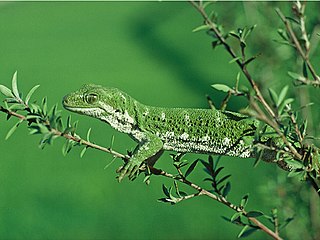This page is based on this
Wikipedia article Text is available under the
CC BY-SA 4.0 license; additional terms may apply.
Images, videos and audio are available under their respective licenses.

Geckos are lizards belonging to the infraorder Gekkota, found in warm climates throughout the world. They range from 1.6 to 60 cm. Most geckos cannot blink, but they often lick their eyes to keep them clean and moist. They have a fixed lens within each iris that enlarges in darkness to let in more light.

Hoplodactylus is a genus of gecko endemic to New Zealand, one of the seven genera of geckos found only in New Zealand. Hoplodactylus comprises two species of large to gigantic brownish lizards, one extinct and one surviving only on predator-free islands.

Naultinus is a genus of geckos that are endemic to New Zealand. On account of their striking colouration, species in the genus Naultinus are commonly known as green geckos. There are eight described species in the genus. Species in the genus share a number of traits that set them apart as quite different from the rest of the world's two thousand odd gecko species, which are generally brown in colour, ovivaparous, short-lived and nocturnal. In contrast, Naultinus are green, ovovivaparous, live up to 30 years or more and are strictly diurnal. New Zealand has a temperate, maritime climate, and in terms of distribution Naultinus is one of the southern-most gecko genera in the world — some species live in habitats in the South Island which receive regular snowfall in winter. Animals in this genus possess several physiological and behavioural adaptations to cope with these periods of low temperatures and adverse weather.

The Northland green gecko or Gray's tree gecko is a species of gecko, a lizard in the family Gekkonidae. The species is found only in the Northland region of New Zealand, north of Whangaroa; it is one of the rarest and most highly sought after lizards.

Diplodactylinae is a subfamily in the family Diplodactylidae sensu lato. In some classifications, it is equivalent to family Diplodactylidae, which is in the infraorder Gekkota. There are 142 species in seventeen genera.

Maungatautari is a mountain, rural community and ecological area near Cambridge in the Waikato region in New Zealand's central North Island.

Melicytus ramiflorus is a small tree of the family Violaceae endemic to New Zealand.

The rough gecko is a species of gecko in the family Gekkonidae native to New Zealand. It is endemic to the Kaikoura Ranges.

The jewelled gecko is a threatened species of gecko endemic to the South Island of New Zealand.

The Marlborough green gecko, also known as the manuka gecko,(Naultinus manukanus) is a small species of gecko endemic to New Zealand. It grows to a maximum of 70mm, and is green, with some individuals displaying gold markings. The underside of the gecko is a lighter green in females, and silvery in males. The holotype is in the collection of the Museum of New Zealand Te Papa Tongarewa.

The Nelson green gecko or starry tree gecko is a species of the family Gekkonidae (gecko). The neotype is in the collection of the Museum of New Zealand Te Papa Tongarewa.

The West Coast green gecko, Lewis Pass green gecko, or warty tree gecko is a species of the family Gekkonidae (gecko).
Pristurus carteri, commonly known as Carter's rock gecko or Carter’s semaphore gecko, is a species of gecko, a lizard in the family Sphaerodactylidae. The species is endemic to the Sinai Peninsula.

The Diplodactylidae are a family in the suborder Gekkota (geckos), with about 137 species in 25 genera.
These geckos occur in Australia, New Zealand, and New Caledonia. Three diplodactylid genera have recently been split into multiple new genera
The Leopold dtella is a species of gecko, a lizard in the family Gekkonidae. The species is endemic to Southeast Asia and Oceania.

Pygopodoidea is a gecko superfamily and the only taxon in the gekkotan subclade Pygopodomorpha. The clade includes three Australasian families: Diplodactylidae, Carphodactylidae, and Pygopodidae. Traditional gekkotan systematics had considered Diplodactylidae and Carphodactylidae as subfamilies of the family Gekkonidae, but recent molecular work have placed Pygopodidae within Gekkonidae making it paraphyletic. These analyses have shown support of Pygopodidae and Carphodactylidae being sister taxa, with Diplodactylidae occupying a basal position in Pygopodoidea.














